Bigeye Trevally, Caranx sexfasciatus
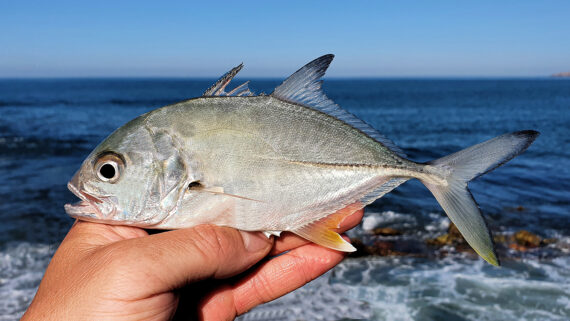 Bigeye Trevally, Caranx sexfasciatus, Juvenile. Fish caught from coastal waters off Mazatlán, Sinaloa, October 2021. Length: 14 cm (5.5 inches). Catch, photograph and identification courtesy of Bart, The Netherlands (worldangler.eu).
Bigeye Trevally, Caranx sexfasciatus, Juvenile. Fish caught from coastal waters off Mazatlán, Sinaloa, October 2021. Length: 14 cm (5.5 inches). Catch, photograph and identification courtesy of Bart, The Netherlands (worldangler.eu).
 Bigeye Trevally, Caranx sexfasciatus, Juvenile. Fish caught from coastal waters off Key Largo, Florida, January 2014. Length: 16 cm (6.3 inches). Catch, photograph, and identification courtesy of Josh Leisen (joshadventures.com), Gaylord, Michigan.
Bigeye Trevally, Caranx sexfasciatus, Juvenile. Fish caught from coastal waters off Key Largo, Florida, January 2014. Length: 16 cm (6.3 inches). Catch, photograph, and identification courtesy of Josh Leisen (joshadventures.com), Gaylord, Michigan.
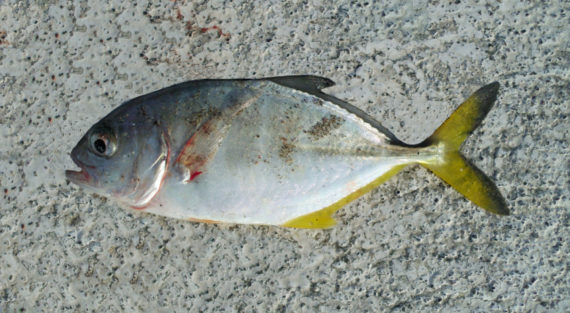 Bigeye Trevally, Caranx sexfasciatus, Juvenile. Fish caught off the jetty at Neuvo Vallarta, Nayarit, January 2019 2015. Length: 22 cm (8.7 inches). Catch and photograph courtesy of Nick Morenc, Mission Viejo, California.
Bigeye Trevally, Caranx sexfasciatus, Juvenile. Fish caught off the jetty at Neuvo Vallarta, Nayarit, January 2019 2015. Length: 22 cm (8.7 inches). Catch and photograph courtesy of Nick Morenc, Mission Viejo, California.
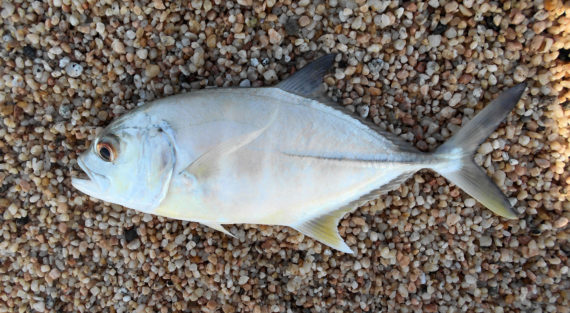 Bigeye Trevally, Caranx sexfasciatus, Juvenile. Fish caught off the beach at Cabo Real, Baja California Sur, July 2015. Length: 25 cm (10 inches). Note that the juvenile is virtually identical to the Pacific Crevalle Jack but lacks the prominent black spot on the gill cover and has black scutes.
Bigeye Trevally, Caranx sexfasciatus, Juvenile. Fish caught off the beach at Cabo Real, Baja California Sur, July 2015. Length: 25 cm (10 inches). Note that the juvenile is virtually identical to the Pacific Crevalle Jack but lacks the prominent black spot on the gill cover and has black scutes.
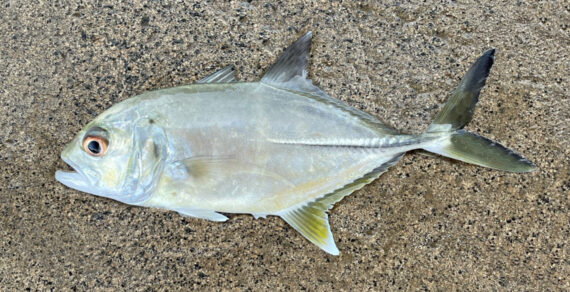 Bigeye Trevally, Caranx sexfasciatus. Fish caught from coastal waters off Kauai, Hawaii, December 2021. Length: 28 cm (11 inches). Catch, photograph and identification courtesy of Luke Ovgard, Klamath Falls, Oregon.
Bigeye Trevally, Caranx sexfasciatus. Fish caught from coastal waters off Kauai, Hawaii, December 2021. Length: 28 cm (11 inches). Catch, photograph and identification courtesy of Luke Ovgard, Klamath Falls, Oregon.
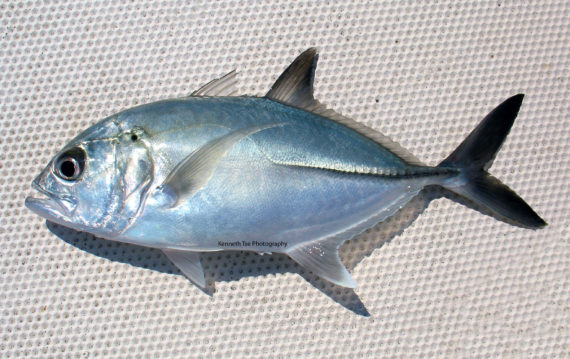 Bigeye Trevally, Caranx sexfasciatus. Fish caught from coastal waters off Mazatlán, Sinaloa, October 2017. Length: 33 cm (13 inches). Catch and photograph courtesy of Kenneth Tse, Toronto, Ontario, Canada.
Bigeye Trevally, Caranx sexfasciatus. Fish caught from coastal waters off Mazatlán, Sinaloa, October 2017. Length: 33 cm (13 inches). Catch and photograph courtesy of Kenneth Tse, Toronto, Ontario, Canada.
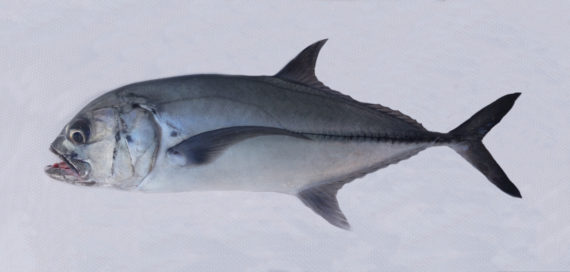 Bigeye Trevally, Caranx sexfasciatus. Fish caught from coastal waters off Loreto, Baja California Sur, May 2019. Length: 76 cm (2 feet 6 inches). Catch, photograph and identification courtesy of Chris Wheaton, Fullerton, California.
Bigeye Trevally, Caranx sexfasciatus. Fish caught from coastal waters off Loreto, Baja California Sur, May 2019. Length: 76 cm (2 feet 6 inches). Catch, photograph and identification courtesy of Chris Wheaton, Fullerton, California.
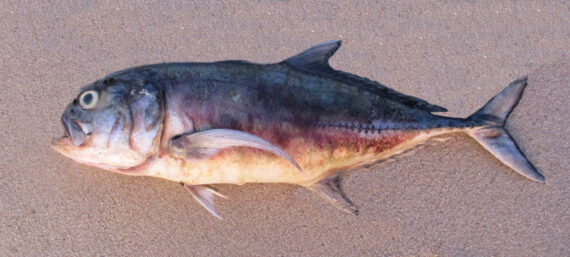
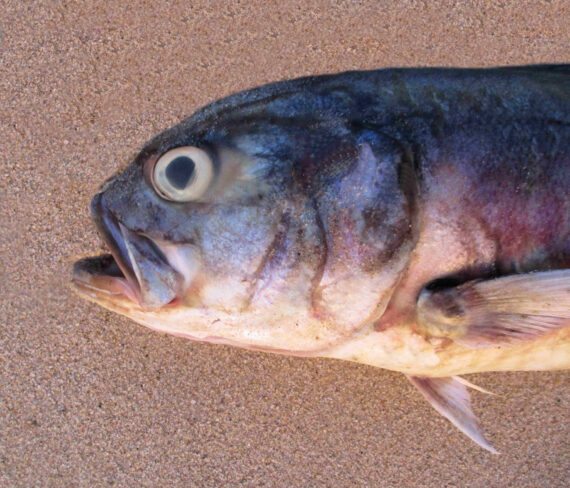 Bigeye Trevally, Caranx sexfasciatus. Fish collected off the beach at Palmilla Beach, Baja California Sur, August 2021. Length: 1.10 m (3 feet 7 inches).
Bigeye Trevally, Caranx sexfasciatus. Fish collected off the beach at Palmilla Beach, Baja California Sur, August 2021. Length: 1.10 m (3 feet 7 inches).
 Bigeye Trevally, Caranx sexfasciatus. Fish caught in coastal waters off Puerto Los Cabos, Baja California Sur, July 2000. Length: 1.15 m (3 feet 9 inches). Photograph courtesy Eric Brictson, Gordo Banks Pangas, La Playita, Baja California Sur.
Bigeye Trevally, Caranx sexfasciatus. Fish caught in coastal waters off Puerto Los Cabos, Baja California Sur, July 2000. Length: 1.15 m (3 feet 9 inches). Photograph courtesy Eric Brictson, Gordo Banks Pangas, La Playita, Baja California Sur.
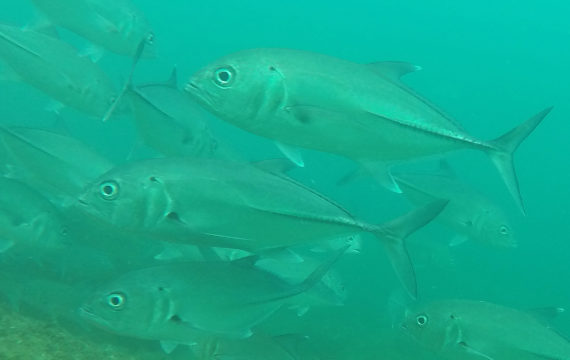 Bigeye Trevally, Caranx sexfasciatus. Underwater photograph taken in coastal waters off Buena Vista, Baja California Sur, June 2017. Photograph courtesy of Bob Hillis, Ivins, Utah.
Bigeye Trevally, Caranx sexfasciatus. Underwater photograph taken in coastal waters off Buena Vista, Baja California Sur, June 2017. Photograph courtesy of Bob Hillis, Ivins, Utah.
The Bigeye Trevally, Caranx sexfasciatus, is a member of the Jack or Carangidae Family, that is also known as the Bigeye Crevalle Jack and in Mexico as jurel voraz. Globally, there are seventeen species in the genus Caranx, of which nine are found in Mexican waters, three in the Atlantic, five in the Pacific, and one in both the Atlantic and Pacific Oceans.
The Bigeye Trevally has a moderately compressed deep elongated body with a depth that is 24% to 28% of standard length. They are iridescent blue-brown dorsally and transition to silvery-white ventrally. They have a small black spot near the upper end of their gill covers and their dorsal fin lobe has a white tip. Their scutes are yellowish-black. They have a rounded head profile with disproportionately large eyes, after which they are named. Their anal fin has 2 spines followed by 1 spine and 15 to 17 rays and an elongated lobe; their caudal fin is widely forked and has a narrow base; their first dorsal fin has 8 spines; their second dorsal fin has 1 spine and 19 to 22 rays and a long lobe; and, their pectoral fins are longer than the head. They have 6 to 8 gill rakers on the upper arch and 27 to 37 gill rakers on the upper arch. Their body is covered with small scales. Their lateral line has a pronounced and relatively long anterior arch and has 27 to 36 strong scutes.
The Bigeye Trevally is a nocturnal pelagic schooling species found at depths up to 96 m (315 feet) that aggregate adjacent to reefs during the day. Juveniles are known to frequent estuaries and freshwater environments. They reach a maximum of 1.2 m (3 feet 11 inches) in length and 14.3 kg (31.5 lbs) in weight. As of January 1, 2024, the International Game Fish Association world record for length stood at 84 cm (2 feet 9 inches) with the fish caught from coastal waters off Panama in November 2011. The corresponding world record for weight stood at 14.3 kg (31 lbs 7 oz) with the fish caught in coastal waters off the Seychelles in April 1997. They are opportunistic predators feeding on benthic and pelagic fish as well as squid and crustaceans. They are a favorite prey of sea lions. The Bigeye Trevally is poorly studied with very limited information available about their lifestyle and behavioral patterns including specific details on age, growth, longevity, movement patterns, diet, habitat use, and reproduction.
The Bigeye Trevally is a resident of all Mexican waters of the Pacific Ocean with the exception that they are absent from the northern half of the Sea of Cortez.
The Bigeye Trevally is most likely confused with the Pacific Crevalle Jack, Caranx caninus (deeper body; dark spot at base of pectoral fin) and the Black Jack, Caranx lugubris (dark fins; dark lateral line).
From a conservation perspective the Bigeye Trevally is currently considered to be of Least Concern with stable, widely distributed populations. In some parts of the world such as the Eastern Pacific and the Indian Ocean (including the eastern, northern, and western coastal waters of Australia), they are a popular and prized game fish for recreational anglers. In other areas they are caught by commercial fishermen utilizing hook and line, gill nets and purse seines and marketed fresh, dried or salted for human consumption. They are abundant at certain times of the year on the Cabo Pulmo Reef, Baja California Sur, where they are seen in massive schools and are of keen interest to scuba divers. They are considered to be a marginal food fish. They have been bread in captivity.